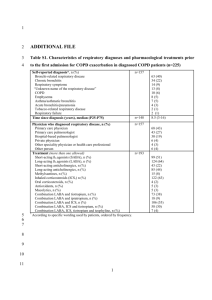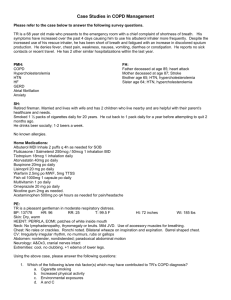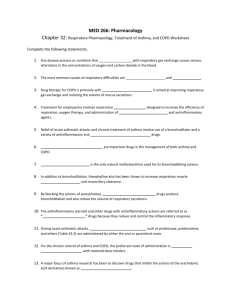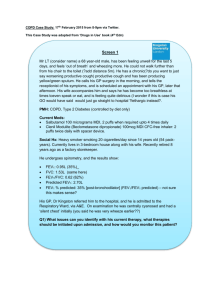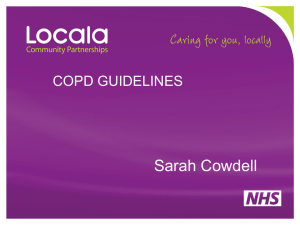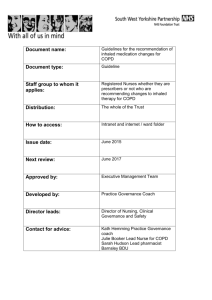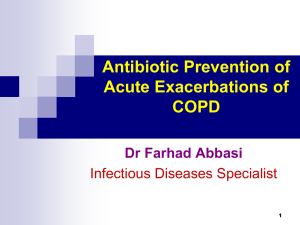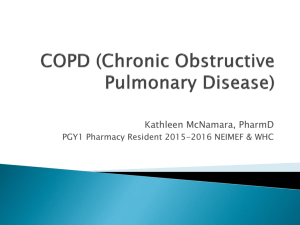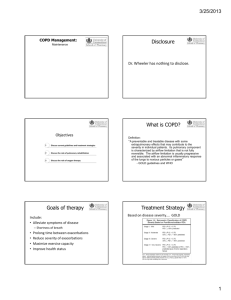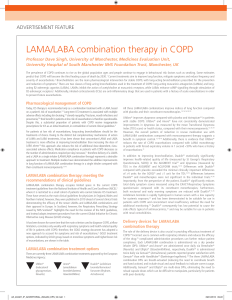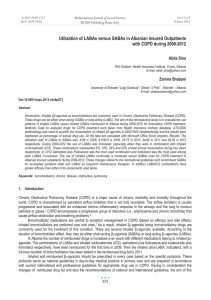TRETN MEDICINES INFORMATION CENTRE
advertisement
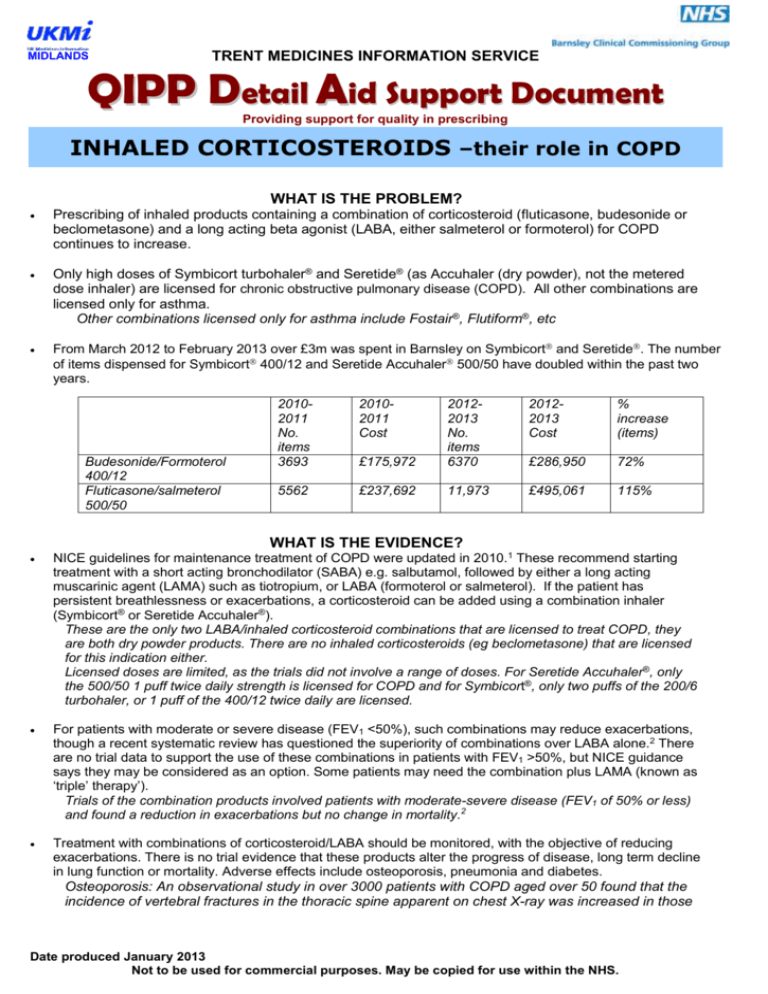
MIDLANDS TRENT MEDICINES INFORMATION SERVICE QIPP Detail Aid Support Document Providing support for quality in prescribing INHALED CORTICOSTEROIDS –their role in COPD WHAT IS THE PROBLEM? Prescribing of inhaled products containing a combination of corticosteroid (fluticasone, budesonide or beclometasone) and a long acting beta agonist (LABA, either salmeterol or formoterol) for COPD continues to increase. Only high doses of Symbicort turbohaler® and Seretide® (as Accuhaler (dry powder), not the metered dose inhaler) are licensed for chronic obstructive pulmonary disease (COPD). All other combinations are licensed only for asthma. Other combinations licensed only for asthma include Fostair®, Flutiform®, etc From March 2012 to February 2013 over £3m was spent in Barnsley on Symbicort and Seretide. The number of items dispensed for Symbicort 400/12 and Seretide Accuhaler 500/50 have doubled within the past two years. Budesonide/Formoterol 400/12 Fluticasone/salmeterol 500/50 20102011 No. items 3693 20102011 Cost 20122013 Cost % increase (items) £175,972 20122013 No. items 6370 £286,950 72% 5562 £237,692 11,973 £495,061 115% WHAT IS THE EVIDENCE? NICE guidelines for maintenance treatment of COPD were updated in 2010.1 These recommend starting treatment with a short acting bronchodilator (SABA) e.g. salbutamol, followed by either a long acting muscarinic agent (LAMA) such as tiotropium, or LABA (formoterol or salmeterol). If the patient has persistent breathlessness or exacerbations, a corticosteroid can be added using a combination inhaler (Symbicort® or Seretide Accuhaler®). These are the only two LABA/inhaled corticosteroid combinations that are licensed to treat COPD, they are both dry powder products. There are no inhaled corticosteroids (eg beclometasone) that are licensed for this indication either. Licensed doses are limited, as the trials did not involve a range of doses. For Seretide Accuhaler®, only the 500/50 1 puff twice daily strength is licensed for COPD and for Symbicort®, only two puffs of the 200/6 turbohaler, or 1 puff of the 400/12 twice daily are licensed. For patients with moderate or severe disease (FEV1 <50%), such combinations may reduce exacerbations, though a recent systematic review has questioned the superiority of combinations over LABA alone.2 There are no trial data to support the use of these combinations in patients with FEV1 >50%, but NICE guidance says they may be considered as an option. Some patients may need the combination plus LAMA (known as ‘triple’ therapy’). Trials of the combination products involved patients with moderate-severe disease (FEV1 of 50% or less) and found a reduction in exacerbations but no change in mortality.2 Treatment with combinations of corticosteroid/LABA should be monitored, with the objective of reducing exacerbations. There is no trial evidence that these products alter the progress of disease, long term decline in lung function or mortality. Adverse effects include osteoporosis, pneumonia and diabetes. Osteoporosis: An observational study in over 3000 patients with COPD aged over 50 found that the incidence of vertebral fractures in the thoracic spine apparent on chest X-ray was increased in those Date produced January 2013 Not to be used for commercial purposes. May be copied for use within the NHS. MIDLANDS using inhaled or oral glucocorticoids, particularly in men. This effect occurred against a background of increased incidence of vertebral fractures in patients with COPD which was related to severity of the disease. Women were similarly affected although the differences between groups in fracture rates associated with inhaled corticosteroids were smaller and not statistically significant.3 Pneumonia: A meta-analysis of 24 trials involving patients with COPD who were using either fluticasone or budesonide combined with a LABA found a statistically significant (56%) increase in risk of pneumonia (relative risk 1.56 (95%CI 1.40-1.74 P<0.0001), compared with a similar group using LABA alone.4 Another systematic review quantified the absolute risk of pneumonia in COPD patients and found that the occurrence of pneumonia was around 3% on patients on LABA alone compared with 4% on combination LABA/ICS treatments, based on 14 studies.2 Based on these data the annualised Numbers Needed to Harm for inhaled corticosteroids causing pneumonia is estimated to be about 60.4 Diabetes: A systematic review found an increase in the rate of diabetes in patients using inhaled corticosteroids (rate ratio [RR] 1.34; 95% confidence interval [CI], 1.29-1.39). The greatest increases in risk were found to be in those using the highest doses of corticosteroids.5 WHAT ARE THE COSTS? £23.75 LABA: Formoterol easyhaler £29.26 LABA: Salmeterol* £33.50 LAMA: Tiotropium 18mcg daily COMBINATIONS Symbicort 200/6 2 puffs bd £38.00 Symbicort 400/12 1 puff bd £38.00 £40.92 Seretide Accuhaler 500/50 1 puff bd £0 £5 £10 £15 £20 £25 £30 £35 £40 £45 * salmeterol (Serevent) as MDI or Accuhaler Costs for 28 days supply based on licensed doses from MIMS/Drug Tariff June 2013 KEY MESSAGES Treatment of COPD is largely aimed at relieving symptoms and in those who have exacerbations, reducing the frequency of these. Evidence for inhaled corticosteroids in COPD is based on trials using combinations with a LABA - Seretide Accuhaler or Symbicort turbohaler in fixed high doses. There is no trial evidence to support the use of Seretide metered dose inhaler in COPD, which is unlicensed and more expensive than the Accuhaler. Evidence is emerging of harms associated with use of long term inhaled steroids in COPD. Continued prescribing should be reviewed regularly and discontinued if exacerbations are not reduced. References 1. NICE guidance (at http://publications.nice.org.uk/chronic-obstructive-pulmonary-disease-cg101/introduction, accessed on 29/10/2012 2. Nannini L, Lasserson T, Poole P. Cochrane review at http://onlinelibrary.wiley.com/doi/10.1002/14651858.CD006829.pub2/abstract accessed 6/11/12 3. Nuti R, Siviero P, Maggi S et al. Vertebral fractures in patients with chronic obstructive pulmonary disease: the EOLO study. Osteoporosis International 2009; 20: 989-998. 4. Singh S, Loke Y. An overview of the benefits and drawbacks of inhaled corticosteroids in chronic obstructive pulmonary disease. Int J Chron Obstruct Pulmon Dis 2010, 5:189-195 (link here) 5. Suissa S, Kezouh A, Ernst P. Inhaled corticosteroids and the risks of diabetes onset and progression. Am J Med. 2010; 123(11):1001-6. ©Trent Medicines Information Service, Leicester Royal Infirmary, LE1 5WW. The information in this review is believed to be true and accurate. It is issued on the understanding that it is the best available from the resources at our disposal at the time of issue. Date produced January 2013 Not to be used for commercial purposes. May be copied for use within the NHS.
